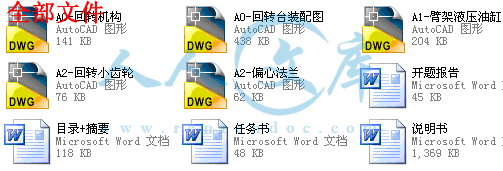【温馨提示】 购买原稿文件请充值后自助下载。
[全部文件] 那张截图中的文件为本资料所有内容,下载后即可获得。
预览截图请勿抄袭,原稿文件完整清晰,无水印,可编辑。
有疑问可以咨询QQ:414951605或1304139763
摘要
随着国民经济的快速发展,建筑结构的的大型化和复杂化对混凝土机械提出了越来越高的要求。具有众多优点和较高经济效益的混凝土泵车得到了普及和应用,混凝土泵车已成为当今建筑施工企业必不可少的专用设备。本文首先介绍了混凝土泵车的结构和特点,重点对混凝土泵车的回转机构和回转液压部分及臂架油缸进行了设计;同时对回转头部件与油缸相连的部件进行了强度校核,并根据泵车零部件标准确定了回转头的主要尺寸及组成部件。回转机构采用液压马达驱动减速器带动回转支承进行旋转,回转头安装在回转支承上随着回转支承转动,从而带动臂架在回转平台上在0~360°范围内转动,臂架展开收拢及其混凝土浇注时定位均是由变幅油缸推(拉)动变幅机构的运动来实现的。
本设计的具体内容主要包括:
1.回转机构、回转液压部分的设计,回转支承装置的选型与计算。
2.回旋支承满足上车布料杆(含混凝土总量)的倾翻力矩的计算。
3.回转台的强度校核及臂架油缸设计系统方案可行,能满足泵车性能要求。
本设计的主要特点是:机构简单,节省投资,控制方便。对目前国内的混凝土泵车的优化设计具有一定的参考价值。
关键词:混凝土泵车;回转机构;回旋驱动部分;液压系统;臂架液压缸;回转台
Abstract
As the rapid development of the national economy,incresing demands have been made by the large and complicated struction of the construction.Pump trucks with many advantages and economic benefits have been used widely and they have been the essential equipment during the contruction today. This paper firstly introduces the structur and features of the pump trucks with the most important of the design of the swing body and calculate the strength of the mechanical parts of the rotary and oil bank and make sure the main sizes and parts of the rotary head according the standard parts of the pump car. The-turn-around-organlitation,makes the decelation machine round by the liquid-press-machine,the rotary head which installed on rotary suface moves by it and makes the Arm turn around during 0°~360°,the function of Arm machine is achieved by the moving of Oil Bank.
The specific contents including:
1.The specific of the Rotary and Rotarry hydraulic part,also the selection and calculation of the Rotarry support.
2.The calculation of the rollover torqne of the Roundabout suport.
3.The projct of thecalculation of rotarry base and the design of the oil urn is resonable and can meet the requirments.
The main features of the design are:simle structure low investment convenient control.The design has some referent value to the domestic optinal design of pump trucks.
Key word: Pumpcrete machine vehicle Swiveling mechanism Maneuver supporting Hydraulic system The tank of boom The turret
目 录
1 绪论 1
1.1 概述 1
1.2 国内外混凝土泵车的发展概况 1
1.3 混凝土泵车的选择与技术管理 3
2 泵车的基本组成及主要技术参数确定 5
2.1 混凝土泵车的基本组成与构造 5
2.1.1 混凝土泵车基本组成 5
2.1.2 混凝土泵车构造 5
2.2 主要性能参数的确定 6
3 混凝土泵车总体结构设计方案 7
3.1 底盘系统设计与选型 7
3.2 泵送系统设计 7
3.3 臂架系统设计 8
3.4 支腿油箱设计 8
3.5 回转机构设计及回转台选型计算 9
3.6 操纵控制系统设计 10
4 回转机构设计 11
4.1回转机构与回转支承装置简述 11
4.2 回转支承装置的选择 13
4.2.1 载荷的确定 13
4.2.2 回转支承装置的受力分析 13
4.2.3 回转支承装置的强度计算 15
4.2.4 回转支承联接螺栓选型及强度校核 16
4.3 回转驱动装置的传动分析 17
4.3.1 回转阻力矩计算 18
4.3.2 马达轴回转功率 20
4.3.3 回转小齿轮设计 20
4.4 减速器的选择 23
4.4.1 明确选择所需技术要求 23
4.4.2 根据机械强度选规格 23
4.4.3 校核热功率 23
4.4.4 校核瞬时尖峰载荷 23
4.4.5 按机械设备总布局要求总体减速机型号 23
5 泵车液压回转系统设计 24
5.1 混凝土泵车液压系统简述 24
5.2 电液比例换向阀在液压系统中的重要作用 24
5.3 回转机构液压系统的设计 25
5.4液压元件主要工作参数的计算与选择 26
5.4.1 液压泵的选择计算 26
5.4.2 液压马达的选择与计算 27
5.4.3 液压控制阀的选择 28
5.4.4 辅助装置的选择 28
5.5 液压系统性能验算 29
5.5.1 液压系统压力损失的验算 29
5.5.2 液压系统总效率的验算 30
5.5.3 液压系统发热温升的验算 30
6 臂架液压油缸设计及回转台强度校核 32
6.1 臂架液压缸的作用及结构 32
6.1.1 液压缸的作用 32
6.1.2 液压缸的结构 32
6.2 液压缸主要零件的材料及技术要求 32
6.3 液压缸设计步骤 33
6.4 液压缸主要零件的设计与计算 33
6.4.1 缸筒计算 33
6.4.2 缸筒底部厚度计算 34
6.4.3 缸筒端部螺纹连接部分校核计算 35
6.4.4 活塞杆及其部分计算 35
6.4.5 最小导向长度的确定 35
6.4.6 液压缸进、出油口尺寸的确定 36
6.5 液压缸的强度校核 36
6.5.1 缸筒壁厚校核 36
6.5.2 活塞杆直径校核 36
6.5.3 活塞杆的弯曲稳定性校核计算 36
6.5.4 焊接缸筒的校核 36
6.6 回转台的选型及强度校核 37
6.6.1 回转台的主要结构 37
6.6.2 回转台底板与回转支承联接螺栓处强度校核 38
6.6.3 回转台油缸连接处的的强度校核 39
结论 41
致谢 42
参考文献 43
附录 44
英文原文 44
中文翻译 59






 川公网安备: 51019002004831号
川公网安备: 51019002004831号